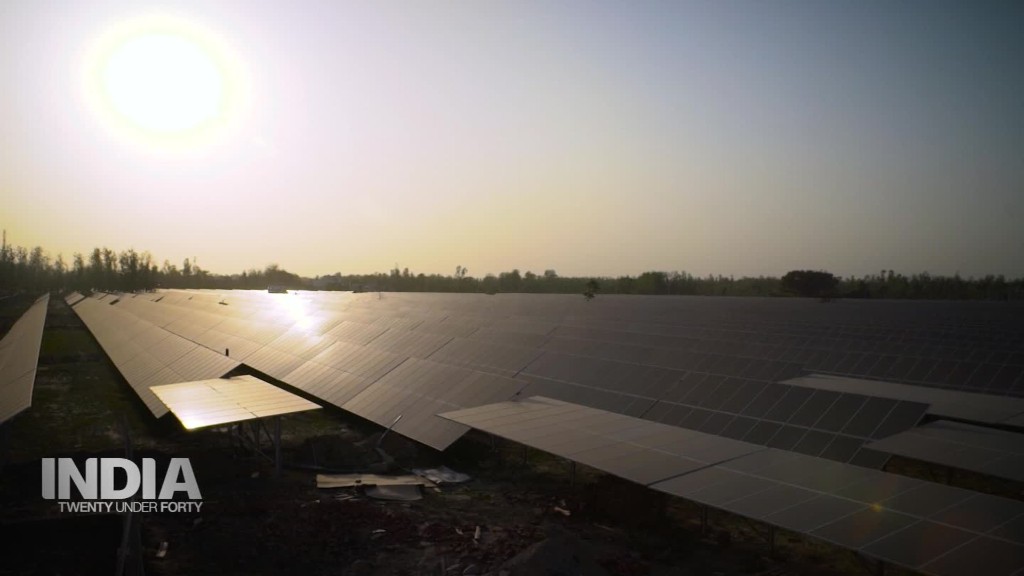
India wants to become a solar powerhouse, generating enough energy for more than 16 million homes by 2022.
The government has approved dozens of new solar plants, rooftop projects and lighting systems, and is offering financial incentives to companies that build them. And Prime Minister Narendra Modi will host the first gathering of the International Solar Alliance in New Delhi on Sunday, with French President Emmanuel Macron in attendance.
But the international summit comes as India's plan to slap a 70% tariff on imported solar panels divides the country's industry. Panel installers say the tariffs could kill any hope of hitting the 2022 target, while panel makers say they're vital to prevent China from gaining too much influence.
'It will jeopardize the entire plan'
China, Taiwan and Malaysia supply between 80% and 90% of India's solar panels, according to industry estimates.
Import duties could make solar electricity up to 45% more expensive, said Sunil Kulkarni, head of the renewable energy business at Shapoorji Pallonji, an infrastructure company.
"These tariffs will hurt the industry," Kulkarni said.
His company has challenged the tariffs in an Indian court, which suspended their implementation pending a ruling. The Indian government did not respond to a request for comment on the tariffs.
India's solar power capacity is around 16,000 megawatts. Under Modi's plan, that should rise to 100,000 megawatts by 2022.
Related: The Indian entrepreneur cashing in on 300 days of sun
Solar project developers say the goal is impossible to achieve without cheap Chinese components.
"[Tariffs] will jeopardize the entire plan," said Ketan Mehta, the founder and CEO of Rays Power Infra. "India does not have the [manufacturing] capacity anywhere close to what we want to do," he added.
Vinay Rustagi, the head of renewable energy consultancy Bridge to India, said a 70% tariff would be "catastrophic."
"Domestic manufacturers are unable to compete with their Chinese competitors because of obsolete technology, sub-scale operations and lack of domestic supply chains," Rustagi said.
India cannot 'blindly' depend on China
Indian manufacturers, however, say a failure to support homegrown production will jeopardize Modi's ambitions by giving China too much control over India's solar industry.
"The Indian solar program cannot be blindly dependent upon China," Dhruv Sharma, CEO of Jupiter Solar Power and one of the leading petitioners for government tariffs, told CNN.
"If you do not nurture domestic manufacturing, and the Chinese know that there is no option but for dependence on them, then anything can happen," he added. "They can just turn off the tap."
He blames cheap Chinese imports for India's weak manufacturing base, while pointing out that local production of solar cells and modules has more than tripled in the last two years.
India could build the capacity to produce all the solar components it needs within 18 months, he added.
India isn't alone in fighting China's solar exports. In late January, the Trump administration imposed tariffs of up to 30% on solar panels from overseas, a move that China slammed as "an abuse" of US trade measures.
Related: Did Trump just start a trade war with China?
Sunil Rathi, director of sales at Waaree Energies, said erecting barriers to Chinese imports would create a level playing field that could eventually allow India to rival China as an exporter of solar equipment.
"Why does the world have to only go to China? It can come to India also," he said. "We can be another promising destination for the world."
Higher trade barriers will force Chinese and Malaysian firms to move their manufacturing to India, Rathi added.
Related: China is crushing the US in renewable energy
Jupiter Solar CEO Sharma argues that strengthening Indian manufacturers will give the Indian government a better chance of achieving its challenging targets -- without being subject to the whims of China.
"A flourishing ecosystem in the country would enable the targets to be met, whereas total dependence on China will always make us vulnerable," he said.
"Have a leap of faith, don't worry about that target not being met. Even if it doesn't get met by 5% or 10%, what difference does it make?"
-- Edwin Thomas contributed to this report


